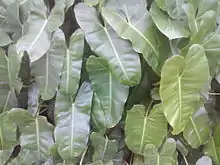imbé
English

Etymology
Portuguese imbé, from Tupian.
Noun
imbé (plural imbés)
- A South American liana, Philodendron imbe.
- 1819, Robert Southey, History of Brazil, page 862:
- Many vessels were built there; and the principal exports were wood and cordage, made of the imbé. The town of Laguna, on the continent, was well situated on the lake which gives it its name, little more than a mile from the bar : [...]
- 1875, Franz Keller, The Amazon and Madeira Rivers: Sketches and Descriptions from the Note-book of an Explorer
- In Brazil there are at least six very different species of this family. [...] The straight ropes on the right are the air-roots of the imbé; [...]
- 1883, Mary Hayden Pike, Ida May, by Mary Langdon, ed. by an English clergyman, page 350:
- Other curious plants grew at this spot, among which I noticed the aninga, a plant which belongs to the Colocasice. On the trees around, too, were many beautiful orchids and lianas, among which the rope-like roots of the large-leaved imbé attracted my attention; [...]
- 1940, Hanna Rydh, Argentine to Andes, page 20:
- Enthroned in the crown, a stately imbé, in the axils leafy bromelia with their gorgeous flowers, along the branches [...]. The lianas, like close-fitting blinds, drew an impenetrable curtain before our eyes; yet we continued to stare bewitched [...]
- 1987, John Hemming, Amazon Frontier: The Defeat of the Brazilian Indians, page 449:
- The weapons they use in these pursuits are finished with extraordinary skill. Their long bows are all veneered with bark from imbé lianas and their arrows are made of a wood of great elasticity and worked so well that they look machine-made.
- 1819, Robert Southey, History of Brazil, page 862:
See also
- imbe (“the African tree Garcinia livingstonei”)
Anagrams
This article is issued from Wiktionary. The text is licensed under Creative Commons - Attribution - Sharealike. Additional terms may apply for the media files.